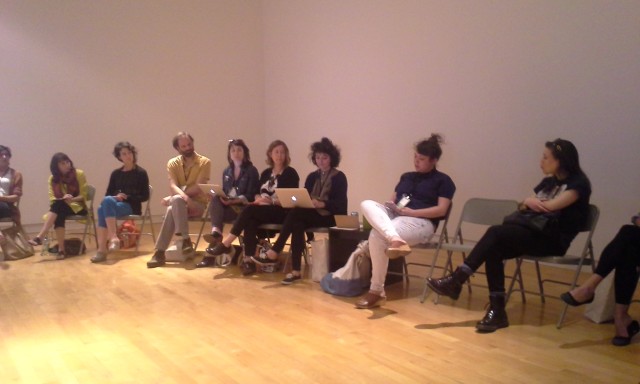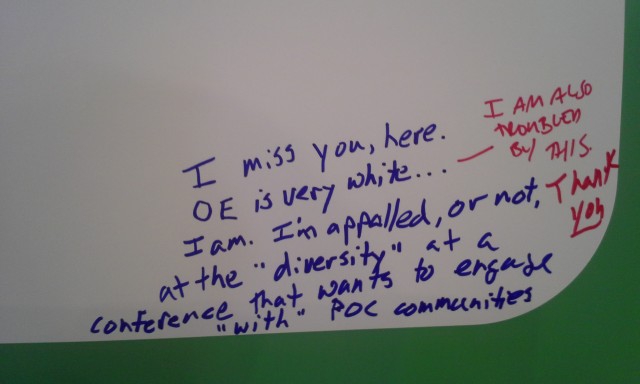In the world of social practice, artists don’t always know what their colleagues are doing. That’s my first take on Open Engagement (O.E.), an annual conference; this year it ran at Carnegie Mellon University in Pittsburgh. The conference itself surely helps remedy that, since it gathers together all types of S.E.A. (an acronym for socially engaged art used by the conference). But, at the same time, the format of O.E. helps perpetuate that confusion; unlike most conferences, no hierarchy is structured into programming, so it’s difficult to know which events are targeted to a larger, more general audience, and which are the niche discussions. Will you enter a classroom or an auditorium? Will you see a PowerPoint presentation or will you be given an artist-made map to McDonald’s? There’s just no easy way to figure this out and it can make navigating the conference a frustrating experience.
And of course, like many conferences it’s impossible to attend all panels, as you’ll have three or four offered at the same time. One panelist said he hadn’t heard the word “revolution” mentioned at all, while at a morning session that was all anyone could talk about. (This kind of disconnect may happen at other conferences too, but here it seemed symbolic of the overall confusion of the event.)
Despite the piecemeal nature of the conference, several issues did emerge. Here’s a few quick observations drawn from the weekend sessions I attended.
- More than one speaker complained of a lax approach to the practice. “The politics in social practice art are so dissolute,” said artist and writer Paige Sarlin, from the “Curation and Criticism” session.
- Contrast that with Sunday’s keynote address by artist and founder of the Project Row Houses, Rick Lowe. He talked about issues that can water down a practice. “What’s the end of social practice?” For him it’s justice. “But I’m not empowered enough to use that word freely,” he said, explaining that it’s hard to do everything you want when you’re so reliant on patrons and funders who might not have the same beliefs as you.
- Key words, phrases, and buzzwords repeated over the weekend included: agency, power structures, strategies, subversion, equity, accountability, p.o.c. (people of color), creative placemaking, and community organizers.
- Words that seem to have dropped out of the discourse, at least for this year: participation, democracy, social work, and antagonism.
- Throughout the weekend, several talks were held in the Miller Gallery at Carnegie Mellon University (CMU). The gallery itself was empty, with no art on the walls, serving as a constant reminder that CMU fired its curator in 2014, with no plans of finding a replacement.
- Some Claire Bishop hatred: “Claire Bishop isn’t friends with artists.” Okay, I have no idea if this is true, but this comment came up during the “Curation and Criticism” session; panelists included editors from FIELD, an academic journal launched by Grant Kester at the University of California at San Diego, and James McAnally of Temporary Art Review, an online publication focused on artist-run and independent spaces. Pretty much, everyone agreed that Artforum-type criticism doesn’t work when reporting on social practice. FIELD members noted that they’re spending over 150 hours each on in-person research and interviews in on community-based project. It’s an intimate type of criticism on social practice where, yes, critics actually talk to artists and community members.
- The nonprofit model isn’t working: During one session, members of Common Field talked about forming a national membership group of artist-run groups, in hopes of creating greater visibility around what each other is doing—especially in terms of alternative funding. In this session, a hundred or so people sat around in a circle, raising their hands to discuss what they’d want out of a national network of groups. Concerns: The government funding model for nonprofits restricts the types of programs you can put on, usually falling into certain specific categories of funding for exhibitions or education. The type of funding available doesn’t reflect the actual projects the organizations want to put on.
- During a session on teaching social practice in higher education, several audience members addressed the potential “problem” of students using social practice art for evil, trying to figure out what to do if a student wanted to partner with the NRA or the Klu Klux Klan on a project. What? This an actual worry?




{ 1 comment }
I’m a fan of Claire Bishop (quite a few of her ideas are more nuanced than they’re given credit for, though my opinion is that she isn’t great at illustrating her points with examples) but the issue of how to critique social practice is tricky.
A while back, an interesting set of conversations around the question sprang up between Grant Kester and Ellen Feiss after Feiss reviewed a project initiated by Tania Bruguera:
The initial review:
http://www.artandeducation.net/paper/what-is-useful-the-paradox-of-rights-in-tania-brugueras-useful-art/
Kester’s first response:
http://www.e-flux.com/journal/the-device-laid-bare-on-some-limitations-in-current-art-criticism/
Feiss’ response to Kester’s response:
http://www.e-flux.com/journal/response-to-grant-kester’s-“the-device-laid-bare”/
Kester’s response to Feiss’ response:
http://www.e-flux.com/journal/response-to-e-c-feiss/
Comments on this entry are closed.